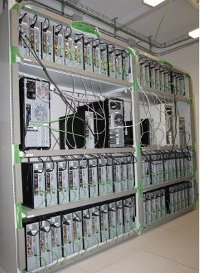 Nuredduna Computer Cluster
Nuredduna Computer Cluster
Mosix Cluster (2009-2012)
Mosix Cluster (2009-2012)
This is a linux computer cluster designed and built at IFISC to perform simulteneously a large number of scientific computations as quickly and efficiently as possible (High Throughput Computing). nuredduna is made with out-of-the-shelf components from the personal computer market a choice which offers, probably, the best performance/price ratio in intensive computation.

nuredduna has been fully operative since August 2000. The original mosix cluster had 21 nodes, one master node (with AMD Athlon at 750 Mhz and 256 MB of RAM) and 20 slave nodes (with AMD Athlon at 800 Mhz and memory ranging from 128 to 756 MB of PC133 RAM).
The mosix cluster was periodically updated and in the 2009 configuration had a total of 120 nodes: 74 of them dual core (Intel Core2 Duo E6600) and 46 Quad Core (Intel Core2 Quad Q6700). It gives a total of 332 cores. Memory raises between 2GB and 8GB of dual-channel DDR2-663 RAM in every node for a total of about 280 GB. Nodes are connected using Gbit ethernet through an HP Procurve 2848 and two Dlink DGS-1248T Gigabit switches.
nuredduna is configured in a fully transparent way for the user which have the same home directory as in all IFISC desktops. The user sees the cluster as a single linux computer. The Mosix kernel patch distributes the computational tasks among the different nodes to balance the load dynamically. Processes are migrated automatically from one node to another without interruption allowing for example to stop or add new nodes, and perform hardware maintenance without stopping any calculation.



